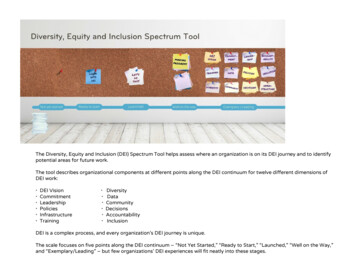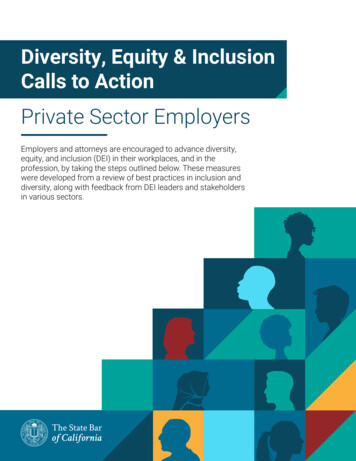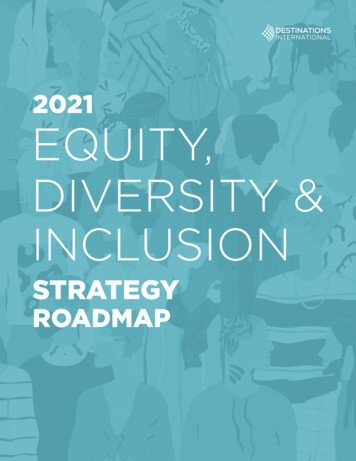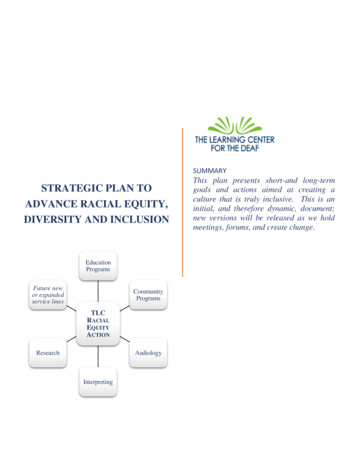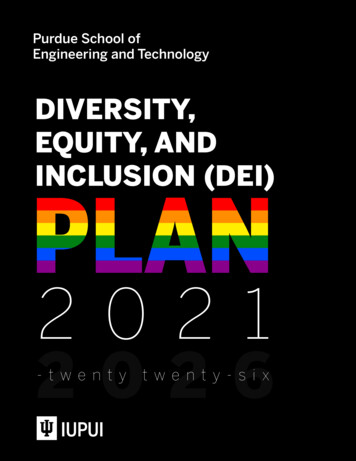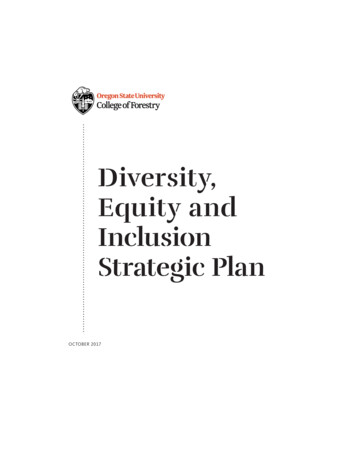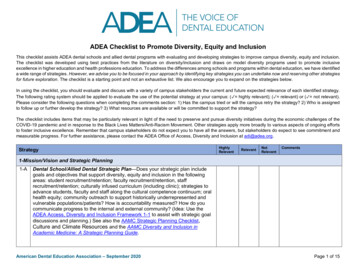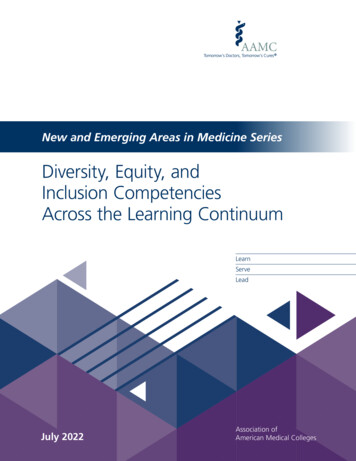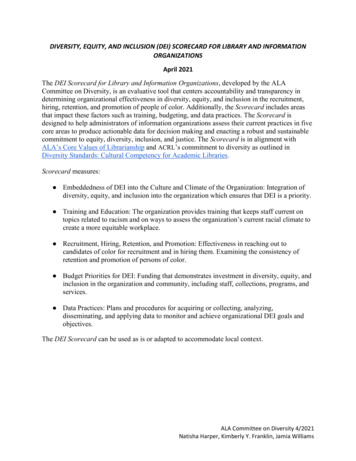
Transcription
DIVERSITY, EQUITY, AND INCLUSION (DEI) SCORECARD FOR LIBRARY AND INFORMATIONORGANIZATIONSApril 2021The DEI Scorecard for Library and Information Organizations, developed by the ALACommittee on Diversity, is an evaluative tool that centers accountability and transparency indetermining organizational effectiveness in diversity, equity, and inclusion in the recruitment,hiring, retention, and promotion of people of color. Additionally, the Scorecard includes areasthat impact these factors such as training, budgeting, and data practices. The Scorecard isdesigned to help administrators of information organizations assess their current practices in fivecore areas to produce actionable data for decision making and enacting a robust and sustainablecommitment to equity, diversity, inclusion, and justice. The Scorecard is in alignment withALA’s Core Values of Librarianship and ACRL’s commitment to diversity as outlined inDiversity Standards: Cultural Competency for Academic Libraries.Scorecard measures: Embeddedness of DEI into the Culture and Climate of the Organization: Integration ofdiversity, equity, and inclusion into the organization which ensures that DEI is a priority. Training and Education: The organization provides training that keeps staff current ontopics related to racism and on ways to assess the organization’s current racial climate tocreate a more equitable workplace. Recruitment, Hiring, Retention, and Promotion: Effectiveness in reaching out tocandidates of color for recruitment and in hiring them. Examining the consistency ofretention and promotion of persons of color. Budget Priorities for DEI: Funding that demonstrates investment in diversity, equity, andinclusion in the organization and community, including staff, collections, programs, andservices. Data Practices: Plans and procedures for acquiring or collecting, analyzing,disseminating, and applying data to monitor and achieve organizational DEI goals andobjectives.The DEI Scorecard can be used as is or adapted to accommodate local context.ALA Committee on Diversity 4/2021Natisha Harper, Kimberly Y. Franklin, Jamia Williams
2DEI SCORECARD FOR LIBRARY AND INFORMATION ORGANIZATIONSLevel of PerformanceEmbeddedness ofDEI into theCulture andClimate of theOrganizationTraining andEducationRecruitment,Hiring, Retention,and PromotionBudget Prioritiesfor tThe library hascreated, outlined, andimplemented DEIwithin its strategicplanThe library providesat least twice-yearlymandatory DEItrainings on currentand systemic issuesthat impact equity inthe organization andthe greatercommunityThe library has a planwith measurablegoals to attract,retain, hire, andpromote BIPOCpersonnel–includinglibrarians–with cleartimelinesFunding for DEIinitiatives isconsistently built intothe annual budgetThe library hasdeveloped but notimplemented DEIgoals within thestrategic planThe library providesannual DEI trainingon current andsystemic issues inlibraries, but staffattendance isvoluntaryThe library is in theprocess ofdeveloping DEIgoals within itsstrategic planThe library isdeveloping but hasnot yetimplemented DEItrainingNo plan is in placeor created toinclude DEI in thestrategic planThe library has aplan for therecruitment,retention andpromotion ofBIPOC personnelThe library has aplan to recruitBIPOC personnel,but it does notinclude retention orpromotionNo plan in placefor recruitment,hiring, retention,and promotion ofBIPOC personnelFunding within thebudget is notspecificallyallocated to DEIinitiatives, but canbe used for theseinitiativesThe organizationhas a protocol andsystem forcollecting,analyzing, anddisseminating DEIdataRequests for fundsrelated to DEIinitiatives is inprocessDEI efforts are notoutlined in thebudgetThe organizationhas begun toconsider developingprotocols andsystems forcollecting,analyzing, anddisseminating DEIdataThe organizationhas no protocols orsystems in placefor collecting,analyzing, anddisseminating DEIdataData Practices The organizationregularly uses DEIdata for decisionmaking andmonitoring progresstowards achieving DEIgoalsThe library doesnot offer DEItrainingsTotal scoreALA Committee on Diversity 4/2021Natisha Harper, Kimberly Y. Franklin, Jamia Williams
3Supplemental QuestionsThese questions can be used to provide context for reflection on the concepts in the Scorecard.The list is not exhaustive but is representative of factors that can be taken into considerationwhen assessing performance on DEI measures.Embeddedness of DEI into the Culture and Climate of the Organization1. Does the library's mission, vision, and value statements identify diversity, equity, andinclusion as central to the organization’s success and wellbeing?2. Has the library established a committee to create initiatives to address DEI issues?3. Does the director develop an annual plan that includes all departments to create bestpractices for anti-racism? This is not education efforts or theory, but actual anti-racistchanges in practice.4. Is there a committee to investigate and reconcile with colonialism and racism? Does thecommittee meet regularly to address concerns and develop protocols, policies, andprocedures to address problems in the organization and recommend solutions?Training and Education1. Does the director and administrative staff of the organization continuously identify needsfor training in critical topics such as anti-racism? Is the training and education used toimplement change?2. Do employees at all levels of the organization have an opportunity for leadership indeveloping anti-racist best practices for DEI training and education?3. Does the organization seek out persons inside/outside the organization who haveexpertise in delivering DEI training and education programs? Are programs generic or dothey meet the specific needs of the organization?Recruitment, Hiring, Retention, and Promotion1. Are candidates asked about their involvement or achievements in DEI on employmentapplications and during the interview process?2. Does the institution provide candidates with information about its involvement orachievements in DEI on employment applications and during the interview process?3. Has the director implemented a process for increasing BIPOC representation inmanagement and administration, which includes transparent pathways to promotion forstaff?4. Are there additional processes to attract a more diverse workforce, including advertisingrelevant jobs in more geographically and demographically diverse venues and on listservsand job boards within POC library organizations?ALA Committee on Diversity 4/2021Natisha Harper, Kimberly Y. Franklin, Jamia Williams
45. Does the director ensure that there is pay equity for BIPOC personnel?Budget Priorities for DEI1. Does the library’s budget include funding for diversifying the collections to includeresources written by or about BIPOC?2. Does the library identify and purchase from local and online BIPOCbooksellers/bookstores and vendors?Data Practices1. To what extent has the organization built capacity for obtaining, archiving, using, andapplying data toward developing an inclusive work environment?2. What are the organization's plans for continuous assessment of DEI?3. How are the data that the library collects used to effect positive change?ALA Committee on Diversity 4/2021Natisha Harper, Kimberly Y. Franklin, Jamia Williams
5Sources ConsultedAmerican Library Association. ALA Strategic Plan (2017 rategic%20Directions%202017 Update.pdfAmerican Library Association. Core Values of om/corevaluesAmerican Library Association. Equity, Diversity, and ociation of College & Research Libraries. Diversity Standards: Cultural Competency forAcademic Libraries (2012). n, E.M., Malcom, L., & Longanecker, D. (2012). Confronting equity issues on campus:Implementing the equity scorecard in theory and practice. Stylus.Center for Urban Education. Equity Scorecard. ke, N.A. “Reading Is Only a Step on the Path to Anti-Racism.” Publishers Weekly. June 19,2020. step-on-the-path-to-anti-racism.htmlCruz, A. M. (2019). Intentional integration of diversity ideals in academic libraries: A literaturereview. The Journal of Academic Librarianship, 45(3), 11The Institute for Diversity and Ethics in Sport. The Racial & Gender Report t-cardALA Committee on Diversity 4/2021Natisha Harper, Kimberly Y. Franklin, Jamia Williams
DEI Scorecard for Library and Information Organizations, developed by the ALA Committee on Diversity, is an evaluative tool that centers accountability and transparency in determining organizational effectiveness in diversity, equity, and inclusion in the recruitment, hiring, retention, and promotion of people of color. Additionally, the .
